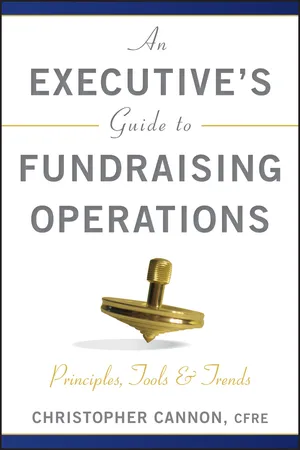
eBook - ePub
An Executive's Guide to Fundraising Operations
Principles, Tools, and Trends
- English
- ePUB (mobile friendly)
- Available on iOS & Android
eBook - ePub
About this book
A straightforward guide to the principles of effective fundraising operations
An Executive Guide to Fundraising Operations provides fundraisers with easy-to-understand approaches to evaluate and address fundraising operations needs and opportunities. This guide simplifies and focuses on the analysis of problems and needs, allowing a quick return to fundraising.
- Provides the essential framework to improve and innovate development operations
- Includes dozens of practical tools, including sample policies for data, database, reporting, and business processes
- Offers sample workflow illustrations for gift processing and acknowledgment, report specification, and other processes
- Features sample reports for campaign management, performance management, and exception management
- Delivers effective calculators for operational rules of thumb
No matter what the department is called, most fundraisers struggle with evaluating operational issues. This guide leads you through principles of effective fundraising operations, simplifies complicated topics, and offers solutions to some of the most vexing operations dilemmas.
Frequently asked questions
Yes, you can cancel anytime from the Subscription tab in your account settings on the Perlego website. Your subscription will stay active until the end of your current billing period. Learn how to cancel your subscription.
At the moment all of our mobile-responsive ePub books are available to download via the app. Most of our PDFs are also available to download and we're working on making the final remaining ones downloadable now. Learn more here.
Perlego offers two plans: Essential and Complete
- Essential is ideal for learners and professionals who enjoy exploring a wide range of subjects. Access the Essential Library with 800,000+ trusted titles and best-sellers across business, personal growth, and the humanities. Includes unlimited reading time and Standard Read Aloud voice.
- Complete: Perfect for advanced learners and researchers needing full, unrestricted access. Unlock 1.4M+ books across hundreds of subjects, including academic and specialized titles. The Complete Plan also includes advanced features like Premium Read Aloud and Research Assistant.
We are an online textbook subscription service, where you can get access to an entire online library for less than the price of a single book per month. With over 1 million books across 1000+ topics, we’ve got you covered! Learn more here.
Look out for the read-aloud symbol on your next book to see if you can listen to it. The read-aloud tool reads text aloud for you, highlighting the text as it is being read. You can pause it, speed it up and slow it down. Learn more here.
Yes! You can use the Perlego app on both iOS or Android devices to read anytime, anywhere — even offline. Perfect for commutes or when you’re on the go.
Please note we cannot support devices running on iOS 13 and Android 7 or earlier. Learn more about using the app.
Please note we cannot support devices running on iOS 13 and Android 7 or earlier. Learn more about using the app.
Yes, you can access An Executive's Guide to Fundraising Operations by Christopher M. Cannon in PDF and/or ePUB format, as well as other popular books in Business & Nonprofit Organizations & Charities. We have over one million books available in our catalogue for you to explore.
Information
Chapter 1
Introduction
The first thing every fundraising executive must know about fundraising operations is this: You cannot know everything. In fact, when it comes to fundraising operations, it is often true that the less you know, the better.
Think about this: If you question your reports, do you trust your data? If you distrust your data, do you have confidence your database? If you worry about your technology, does that make you wonder about your processes and procedures? And if you begin to distrust all of those things, how does this make you feel about your people?
The answers to each of these questions are interdependent. One bad report. One bad acknowledgment letter. One bad apple. Any of these things can affect your trust in your fundraising operations. Once that trust is bruised, it is easily broken. All of this diminishes fundraising success.
But should this be the case? How much of this can be attributed to perception, and how much is “real”? How can you determine what is systemic versus anecdotal and trivial? Are there tricks that will help you work through the occasional misstep while maintaining an eye on the measures that matter? Most importantly, are there tools that will help you understand and improve complicated processes or systems in fundraising operations?
This guide puts these crucial issues into perspective. Without the right filters and efficient evaluation tools, you can quickly become mired in details. You require the necessary tools to manage even the most complex aspects of your operations while maintaining focus on fundraising. You will find these tools here.
Supporting Fundraising
To the professional, there is little mystery behind fundraising. Constituents become donors when they are convinced of the merits of the charity's mission. Effective fundraising organizations arrange their programs and efforts to capitalize on the interest and generosity of groups of constituents. If the organization's impact is meaningful enough and the fundraisers organize appropriately, fundraising results should follow.
This is a simplistic interpretation, to put it mildly. Fundraising managers know that success depends on dozens or even hundreds of moving parts, people, and programs to manage throughout the fundraising process. In addition to the essential relationship building of the job, many organizations are increasingly relying on fundraising operations—and all of its potential intricacies—to contain as many moving parts as possible.
The fundraising operations that support philanthropy are often shrouded in mystery. The technology involved is typically complex and out of the chief development officer's area of expertise. Assessing data integrity issues is difficult. Understanding why certain reports match up and others do not is frustrating. And knowing whether the people and processes in place are efficient and effective can be time consuming.
This guide is written for the fundraising executive. Through case studies, descriptions of best practices, and helpful evaluation tools, the busy fundraising executive will acquire tools and tricks to simplify fundraising operations. Throughout this guide, the focus is on how you should evaluate between success, mediocrity, and failure—quickly, accurately, and efficiently.
What Is Fundraising Operations and Where Should It Fit in the Organization?
“Operations” can be a broad area for many institutions. The framework for operations, the name for the “operations” team, and the team's responsibilities shape expectations. Any analysis of operations should include shared language and expectations. Environmental and organizational factors also affect operations and outcomes.
Fundraising Operations: What's in a Name?
This executive guide is necessary partly because the profession has not really figured out what to call it or what it includes. Fundraising executives manage a variety of teams, functions, and positions that may broadly fall into the category of “fundraising operations.” A particular executive's view of fundraising operations has many factors that affect the definition.
For some fundraising organizations, the first part of this subject— “fundraising”—may not fit. In higher education settings, offices have increasingly exchanged fundraising with the newer, more comprehensive descriptor, advancement. Others prefer development. The frequency of usage of foundation, alumni, constituent, institutional, and other options starts to illustrate the many ways an executive may define fundraising operations.
In other organizations, the difficulty is with the second part of the name: operations. Some groups include responsibilities such as human relations, finance, and facilities maintenance in the notion of “operations.” Indeed, some fundraising teams have just such responsibilities. In other cases, financial reporting, endowment management, database administration, network and computer systems management, and a host of other functions are included or excluded.
The choice for this guide is to label it “fundraising operations,” while maintaining the right to use other popular labels throughout the book. There are certainly benefits to adopting some of the broader descriptors here. For example, “advancement services” reflects additional areas supported, such as alumni relations, communications, and marketing frequently found in higher education. The choice of “fundraising operations” is not intended to limit the scope of the guide, but instead to apply the material to the largest possible audience of fundraisers.
The data suggest other alternatives to “fundraising operations.” I conducted a survey of a few thousand fundraising executives and operations professionals to understand the issue of naming departments, as well as other topics. The survey generated 373 completed requests. The results of this survey are referred to here and elsewhere in the book as the fundraising operations survey. Table 1.1 presents what the data suggest about naming conventions for divisions.
Table 1.1 Which word most closely matches how your organization refers to your division?
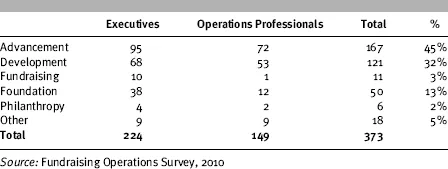
“Advancement” is the clear winner. It is important to note that the majority of respondents were from universities, so this outcome makes sense. The next table (Table 1.2) suggests that “Services” is the most prominent moniker for all of the work that fundraising operations entails, including data, technology, reporting, and processes.
Table 1.2 Which word most closely matches how your organization refers to your team dedicated to data, technology, reporting, and business processes?

The issue of title(s) is important for your organization. These options may or may not apply, but what you call this area can shape what you expect and what the team delivers. As you review this book, think about how your departmental and position titles for “fundraising operations” areas affect your expectations of what such operations should or could do. Does your group's title properly reflect your expectations of the team? Do overlapping or competing groups’ responsibilities in this area affect confidence in the productivity of all operations? These and other questions will be revisited throughout this guide.
What Does “Fundraising Operations” Include?
Some organizations view these operations narrowly while others treat the area like a catch-all for any nonsolicitation activity. No matter the size or complexity of your organization, the following five factors make up the central framework for fundraising operations.
In general, the framework for every fundraising operations team includes:
1. Data, including constituent, prospect, donor, and member information
2. Technology, such as your database and online community tools
3. Reporting, from the database, a special reporting tool, or products like Microsoft Excel
4. Processes and programs, which are highly variable depending on each organization's needs, historic expansion and development, and other factors
5. People, who do the actual work of fundraising operations
For your organization, you should be able to visualize your operations team through the following framework diagrams. Notice that Figure 1.1 depicts a balanced arrangement; you can envision spinning this like a top. Because everything is well managed, the top spins smoothly. However, Figure 1.2 depicts an unbalanced arrangement where data issues are out of hand. You can imagine that this framework cannot smoothly support fundraising needs until the out-of-balance data issues are addressed.
Figure 1.1 Components of the Operations Framework (The “Top”)
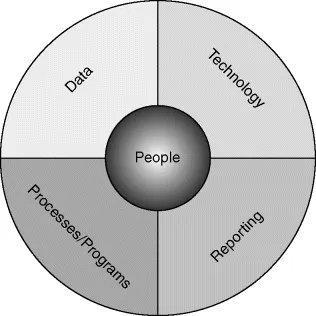
Figure 1.2 Imbalanced Operations Framework
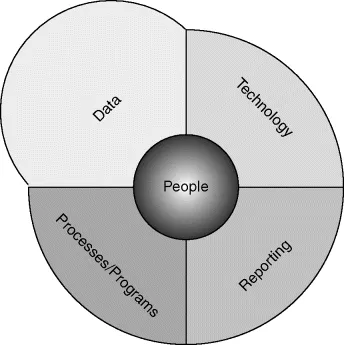
This guide will direct fundraisers toward the easiest ways to understand the source of problems and areas of opportunity. Chapter 2 examines how each of these framework elements should be evaluated. These will then be analyzed frequently throughout the book to explain what is truly important, what is simply urgent, and what can be altogether ignored. A balanced framework makes a significant difference in how effectively your operations team meets the demands of fundraising. The same framework applies if you are responsible for broader teams, such as the “advancement division” or “external relations team.”
Within the construct of the balanced fundraising operations framework, your organization likely handles many of the responsibilities and perhaps shares some duties or has delegated some processes to other departments in your organization. Figure 1.3 illustrates the types of work and responsibilities for fundraising operations. The most likely responsibilities are in white boxes. Gray boxes represent those areas that are less frequently assigned to fundraising operations. The black boxes indicate responsibilities that tend to apply only to a select few nonprofits’ fundraising operations teams.
Figure 1.3 Operations Responsibilities
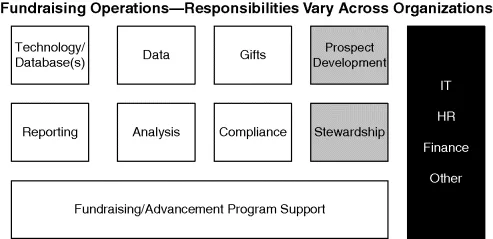
Your organization's situation will dictate which of these responsibilities are important to you. Chapters 5 and 7 on trends and tools, respectively, present efficient and effective management resources to ensure these responsibilities are properly handled.
The notion of the spinning top depicted in Figures 1.1 and 1.2 and operations’ responsibilities presented in Figure 1.3 are the foundation for this guide. If you learn the details to each of these elements, you will understand the essential operations issues that affect fundraising. The trick is, of course, that these diagrams depict brief snapshots of exceptionally complex, interrelated issues. The two-dimensional representation here does not do justice to the complicated moving parts involved in fundraising operations. This book will help you determine what to care about, how to evaluate areas that are important to you, and when to be worried.
Your perspective and perception of these components and this framework shape your expectations and responsibilities. These core factors are the subject of Chapter 2, “Principles of Fundraising Operations.”
Organizational and Environmental Factors Shape Operations
Fundraising organizations typically become a living, breathing extension of their organizations’ missions. Fundraising for big organizations often mimics the large, complicated structural arrangements that support, say, international environmental conservation efforts. Fundraising operations for these groups often includes lots of systems; lots of connecting points for data, reporting, and training; and lots of impact spread over expansive areas. However, small organizations often manage via the unpopular idiom “do more with less.” These groups sometimes saddle operations staff with too many responsibilities and too few resources to successfully meet demands. Most organizations are somewhere in the middle, with dedicated operations staff, appropriate software applications, and sufficient resources.
In all cases, fundraising executives have an opportunity to seek balance between complex and simple, big and small. Your lens for uncovering this opportunity likely adjusts based on your organization, so let's start there.
Size of Organization
Larger fundraising organizations tend to have more sophisticated hierarchical structures. Consider my position at the Saint Louis Zoo, a $38 million operation with over 300 full-time employees managing a world-class zoological park in St. Louis's Forest Park. Our small fundraising team size resulted in expansive roles and responsibilities, even if the ability to tackle each role was somewhat shallow. We were a small but mighty team, giving meaning to the “lean and mean” badge often worn by fundraisers at smaller shops. We simply did not have staff to take on specific roles, so team members stepped up to take on new duties as needed. A “day in the life” at the Saint Louis Zoo could include giving a prospective donor a behind-the-scenes tour of Big Cat Country, then conducting a prospect management meeting, then updating the database, and eventually managing an event, producing a campaign collateral piece, or writing a grant proposal. When I moved to a larger team at Saint Louis University, my title narrowed, my roles condensed, and my responsibilities deepened in te...
Table of contents
- Cover
- The AFP Fund Development Series
- Title Page
- Copyright
- Dedication
- Foreword
- Preface
- Acknowledgments
- Chapter 1: Introduction
- Chapter 2: Principles of Fundraising Operations
- Chapter 3: Responsibilities of Your Fundraising Operations Team
- Chapter 4: Program Support
- Chapter 5: Trends, Fads, and Staying Ahead of the Curve
- Chapter 6: Decision Advice from the Field
- Chapter 7: Tools for Fundraising Operations
- Epilogue
- Appendix A: Sample Data Dictionary
- Appendix B: APRA Statement of Ethics
- Glossary
- Bibliography
- About the Author
- AFP Code of Ethical Principles and Standards
- A Donor Bill of Rights
- Index